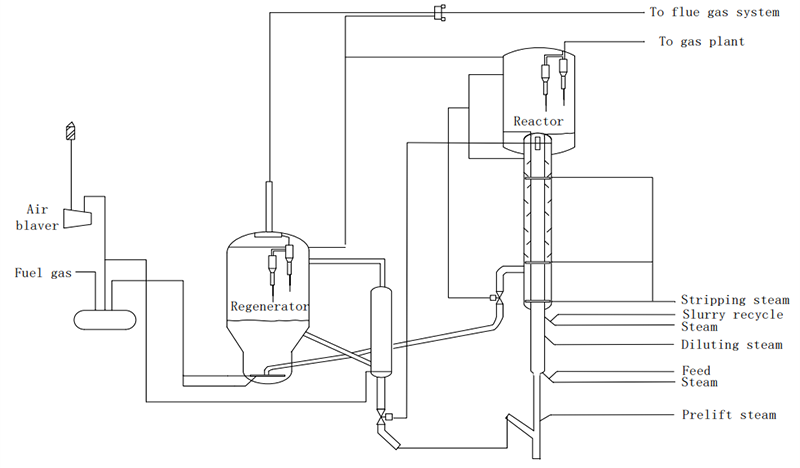I. Introduction
1. Background
The Catalytic Pyrolysis Process (CPP) developed by SINOPEC is a novel technology aiming at producing ethylene and propylene directly from heavy oil, which is a new way of getting petrochemical products from heavy feed stock. The cracked naphtha from CPP unit can be used as gasoline blending component with high octane number, or as chemical raw material for BTEX.
2. Process Description
The process scheme is similar to that of FCC, which is mainly composed of reactor, regenerator and product separation and recovery system.
The schematic diagram of CPP reaction-regeneration system is shown in Fig.1.
After being heated by a pre-heating oven, heavy feed stock is sprayed into the bottom of the reactor via a high-efficiency atomization nozzle, then contacts and reacts with the hightemperature catalyst from the regenerator. The cooled cracked gas goes to product recovery system after heat exchange. After stripped by steam, the spent catalyst is fed into the regenerator where the coke deposited on the catalyst was burned out. Then the regenerated catalyst goes back to the bottom of the reactor, and is recycled to use.

3. Key operating Parameters
Typical operating conditions of the CPP process is listed as follows:
The reaction temperature: 590~610°C,
The absolute pressure during reaction: 0.18~0.22MPa,
The ratio of steam to feed: 25w% ~ 35w%,
The ratio of steam to feed: 25w% ~ 35w%
II. Technology Characteristics
1. Operation Flexibility
CPP technology has three operating modes, those are the mode for maximizing ethylene production (Mode I), for maximizing propylene production (Mode III), and an intermediate mode for maximizing ethylene and propylene production (Mode II).
2. Feedstock Adaptability
CPP technology is suitable for processing heavy feedstocks, such as VGO, VGO mixed with residual oil, CGO and DAO, AR, etc., which expands the source of feedstocks for ethylene production and reduces the cost of the feedstocks.
3. Main Performance
The results of the commercial performance test show that the yield of ethylene are 20.73wt%, 13.71wt% and 9.77wt% for Mode I, Mode II and Mode II, respectively, propylene yield is 18.23wt%, 21.45wt%, 24.60wt%, respectively.
The purity of ethylene of the commercial plant is above 99.99v%, and that of propylene is at least 99.9v%, both of which have come up to the standards of high-class product.
4. Running Cycle
The running cycle of a CPP unit is the same as that of the traditional FCC units, which is usually 3 to 5 years.
III. CPP Catalysts
The properties of the catalyst which is specially designed for CPP process are shown in Table 1. Except for higher attrition index, the other physical properties of CPP proprietary catalyst are quite close to that of traditional FCC catalyst.
Table.1 properties of CPP proprietary catalyst
| Items | Catalyst for CPP |
| Specific surface areas, m2/g | 150~160 |
| Pore volume, mL/g | 0.22~0.30 |
| ABD, g/mL | 0.80~0.90 |
| Attrition index, m%/h | 0.90~1.00 |
| APS,μm | 65~80 |
IV. Commercial Experience
Two CPP units have been put into production up to now, and the biggest capacity of which is 1.50 MT/a.

